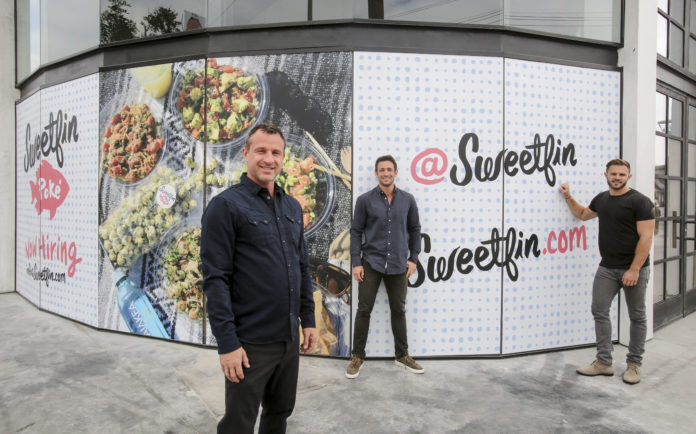A wave of Hawaiian soul food has crashed ashore in Santa Monica, and it doesn’t seem the poké trend will wash away anytime soon.
Santa Monica’s Sweetfin Poké is readying a five-store expansion across Los Angeles before the year’s end. The company’s most recent deal, in June, includes a spot nabbed in West Hollywood, where the group of co-owners is eyeing an early fall opening.
“We call poké the evolution of sushi”, said Seth Cohen, one of Sweetfin’s four co-founders. Their fast-casual concept, averaging $13 a meal, serves up dishes of marinated raw fish, which sits atop a base of salad or rice.
Cohen said poké’s sushi-like appeal inspired him and business partner Brett Nestadt to start researching a concept in 2013 that would be adaptable for expansion outside the region. With restaurateur Alan Nathan on board and chef Dakota Weiss heading the restaurant’s culinary operations, the team opened up shop in Santa Monica in April of last year.
Business has been taking off for the year-old venture. First-year revenue for Sweetfin’s inaugural location hit $3 million, Cohen said. The shop, located on Broadway a few blocks east of the Third Street Promenade, averages around 90 transactions an hour – well above preopening expectations of about 60 transactions.
Poké has long been a staple in traditional Hawaiian cuisine, but the healthy dish picked up steam in Los Angeles last year, when dozens of restaurants specializing in the raw fish dish began to emerge – and expand – across the region. Santa Monica’s Seasalt Fish Grill hooked a location downtown last year and Mainland Poké Shop in Beverly Grove has a second restaurant opening in Glendale later this year.
“A key differentiator between what we’re doing and what other poké shops have done is rooted in our truly unique chef-driven concept that’s fueled by our partner Dakota,” Cohen said. “It’s California inspired with a Japanese flare, not explicitly traditional.”
Sweetfin announced in January that it had it raked in a financing deal backed by former Shake Shack Chief Executive David Swinghamer, who’s also on board as one of Sweetfin’s strategic advisers. Other investors include hospitality veteran Larry Mindel, founder of California’s Il Fornaio restaurant chain, and a New York private equity investor.
The terms of Sweetfin’s funding round were not disclosed, but owners said they have closed on deals for four locations: downtown, Larchmont Village, Westwood, and Canoga Park.
The next location to open will be at the Village at Westfield Topanga, where a 1,700-square-foot space is set to open next month. It will be the largest location thus far; the flagship Santa Monica store is 1,000 square feet, as is the West Hollywood outpost.
Gone fishing
Cohen and Nestadt, both 28, met while students at USC. They had planned to enter finance and film, but switched to restaurants after they discovered poké on a 2013 trip to Hawaii. With limited experience in the industry, the two turned to Nathan, a Nestadt family friend and former chief executive of Beverly Grove’s Choice Hospitality Group.
“Alan immediately connected with the concept,” Cohen said.
Nathan, who was running food and beverage at the W Hotel Westwood, discussed the idea with Weiss, the hotel restaurant’s executive chef at the time. Armed with a team of partners, the group took in a private family-funded round of initial investment to set up shop in Santa Monica.
“The environment continues to be robust for people investing in growth restaurant concepts,” said Rahul Aggarwal, a partner at West L.A.’s Brentwood Associates, a private equity firm that invests in restaurant concepts.
He added that seafood offerings in general provide fundamental growth capacities due to an increase in customers looking for healthier food options.
Brentwood invested in San Francisco-based Pacific Catch in April.
“It’s polished casual dining, not fast casual, but they sell a lot of poké,” Aggarwal said. “It’s a product in the industry that’s really catching with consumers.”
Things have gone swimmingly for Sweetfin from the start – perhaps too swimmingly.
“The first day we were open, we got hit hard with a rush of people, which was great,” Cohen said. “But the amount of orders we were taking in an hourlong period was a lot to deal with – it affected our staff’s morale.”
It got to the point during Sweetfin’s first two weeks where the partners decided it was best to close for a few hours in the middle of the day in order to regroup and prepare more food for the evening. They said everything at Sweetfin, from drinks to sauces, is prepared in-house.
“We had to adapt to demand,” Nathan said.
Weiss added that with the new locations, the larger locales, namely the 1,700-square-foot Topanga Westfield shop, will serve to prepare food in greater quantities for use at smaller locations.
The team also said Sweetfin’s West Hollywood location will offer beer and wine, a first for the company. But consistent with the restaurant’s Santa Monica beginnings, the service counter will serve as the central focus, where customers will order and customize their bowl before taking a seat and awaiting delivery.
“Sweetfin came out at a time when the customization trend was really taking off,” Nestadt said, noting the 95 million possible combinations available at Sweetfin.
“We spent nearly two years doing research and development because our ambitions include creating a concept we can replicate in different markets, with systems we can put in place allowing us to do that,” Cohen said.
Sweetfin’s five new L.A. locations are expected to open by the fall, the team said. The most difficult part – closing on deals for the new outposts – is complete.
“I was in the sushi business back in 1999 when people were asking if sushi was here to stay,” Nathan said. “I think sushi’s proven that it’s here to stay and we feel the same way about the future of poké.”

